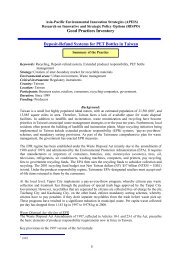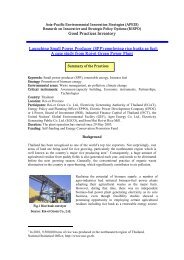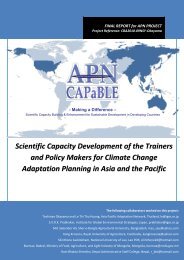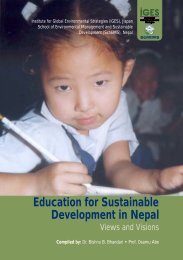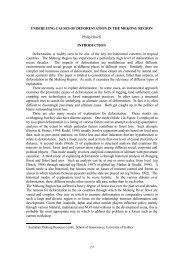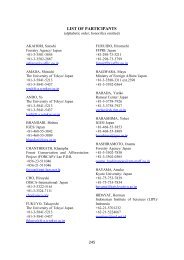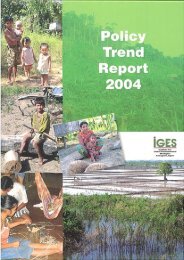final evaluation report akk_iges_final.pdf - IGES EnviroScope
final evaluation report akk_iges_final.pdf - IGES EnviroScope
final evaluation report akk_iges_final.pdf - IGES EnviroScope
You also want an ePaper? Increase the reach of your titles
YUMPU automatically turns print PDFs into web optimized ePapers that Google loves.
APFED Project Final Evaluation Report 2011<br />
(preoccupation)<br />
3. Community attitudes of getting direct services from the project to meet other felt needs related to<br />
primary health care and livestock care<br />
4. Extremely marginal economy and subsistence living of families in char lands<br />
5. Government institutions and structure is well set for response and not for climate risk reduction.<br />
6. Absence of official mandate to engage staff of relevant government departments to integrate<br />
climate risk reduction<br />
8. Government has no resources to facilitate this kind of climate risk reduction processes at the<br />
community level<br />
9. There is a fear of creating dependency attitude among the community<br />
Critical issues requiring attention<br />
• Addressing diversified needs of people relevant to reduce causes of vulnerability especially<br />
including gender issues<br />
• Through the formation of village based community organization, institutional linkage and<br />
relationship building between CCMCs and government departments the project has created some<br />
sustainability potentials. However, the utterances of CCMC members presented in Table 4 inform<br />
that CCMCs are not yet confident enough to take up the process by their own. Reasons of not<br />
being able to run the process are:<br />
• CBOs have no enough funds to operate at village level<br />
• CBO don’t have its own staff to facilitate the processes on a long term basis<br />
11. Participation<br />
According to the Table 7, all the respondents were of the view that the project has created congenial<br />
environment for women’s participation. On a scale of 1 to 100, both male and female respondents<br />
were in agreement that women participation in community development activities has gone up from 5<br />
to 70%. Data in Table 7 also complement that now women are more aware about women rights and<br />
raising collective voice and actions to establish their rights to participate.<br />
Table 7. Participation in the project as <strong>report</strong>ed by the respondents.<br />
43



